
The Love Child of Robert Ludlum and Jane Austen
Movie Pitches
Although there is some overlap, especially of the last two, the proper viewing sequence would be:
- Jane Austen: Termination With Pride and Extreme Prejudice
- Jane Austen: Pride of Frankenstein
- Jane Austen: Jane Mansfield Park
- Jane Austen: The Austen Identity
- Jane Austen: Pride and Predator
- Sherlock's Ladies
- Jane Austen: The Biomechanical Woman
- Jane Austen: Emma Anime
- G.I. Jane Eyre
- Really Little Women
- RLW2: Even Littler
JANE AUSTEN: TERMINATION WITH PRIDE AND EXTREME PREJUDICE [action/adventure]
Based on a story by Jane Austen, PRIDE AND EXTREME PREJUDICE introduces us to Jane and Elizabeth, two of five unmarried daughters of the Austen family. The Austen family is not wealthy, but they have a reasonably comfortable life outside London in the late 1700's.
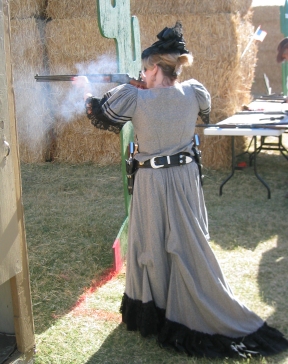
Charles Bingley, a dandy from London, falls in love with Jane when he meets her on a visit to the country. Meanwhile, Bingley's uncouth friend Fitzwilliam Darcy insults Elizabeth and thus wins the sisters' disapproval. Furthermore, Darcy is rumored to have connections to the more restive factions of the American colonies. He will be hosting Benjamin Franklin during his visit to England to plead the colonies' case for a relief from the more punitive taxation. This is a political connection that wins him no favor from the staunchly royalist Austen clan.
A few weeks later, Bingley is intrigued when he runs into Jane in the city. What could she be doing there on her own?
Bingley follows Jane, and is astounded to see her admitted into the War Ministry headquarters in the Whitehall district. He waits several hours until she leaves, and follows her to the entrance of a boarding house where he confronts her. She breaks away from him and runs upstairs. He follows, barging into her room.
He is dumbfounded to find that she has been living a double life: both the demure country girl he thought he knew, but also a street-wise tough woman of the city. A woman whose boarding house room contains several carefully-studied sailing timetables and sketches of both Darcy and the American Franklin, along with a colonial long rifle sporting a most unusual attachment. When pressed, Jane admits that the rifle's attachment is a sort of telescope known as an "optickal sight", a secret invention that Sir Isaac Newton had created for the War Ministry.
Yes, Jane is secretly a government assassin with a contract to take out the prominent visiting stateman. Will she succeed in her mission? Will Bingley stop her? Will the insult to Elizabeth at the country cotillion be avenged? All questions are answered in the shocking conclusion to PRIDE AND EXTREME PREJUDICE!
JANE AUSTEN: PRIDE OF FRANKENSTEIN [action / horror]
Jane and Elizabeth, two daughters of the Austen family, live a reasonably comfortable life outside London. Charles Bingley, a dandy from London, falls in love with Jane. Meanwhile, Bingley's uncouth friend Fitzwilliam Darcy insults Elizabeth and thus wins the daughters' disapproval.

Jane and The Creature
Furthermore, Darcy is scandalously rumored to have some connection to a series of defilements of fresh graves. Some whisper that his involvement is at the behest of the mysterious Doctor Frankenstein newly arrived at his ancestor's castle on the high promintory overlooking the river. Jane, who we know from TERMINATION WITH PRIDE AND EXTREME PREJUDICE to be a government assassin, is asked by the War Ministry to step in after rumors of the assembly of some creature from components of the recently deceased are followed by gruesome late-night slaughters of local livestock.
Will she use her colonial long rifle with its "optickal sight" designed by Isaac Newton (himself secretly in the employ of the War Ministry in his day)? Or will she convince the monster to behave properly through a gentle comedy of manners?
JANE AUSTEN: JANE MANSFIELD PARK [action/adventure]
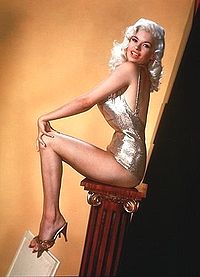
Fanny Price
A number of romantic entanglements and comedies of errors enliven things in the small English town. The voluptuous blond Fanny Price has a mysterious past, but soon all the men are smitten.
One of them, Henry Crawford, falls in love and asks Fanny to marry him. She unexpectedly turns on him, blackmailing him for insider details of the Antiguan sugar cane plantation run by the family patriarch Sir Thomas Bertram. If he does not turn over the details immediately, she will expose what Henry thought was his long-buried secret of inappropriate behavior toward his cousins.
What Henry did not realize is that "Fanny Price" is none other than Georgian-era spy-assassin Jane Austen in a deadly deep-cover operation. His Majesty's British government needs control of the Caribbean rum trade, and Jane Austen is on the case!
JANE AUSTEN: THE AUSTEN IDENTITY [action / suspense]
1815: A fishing vessel discovers a young woman clinging to floating debris from a sunken ship well south of the French coast in the Mediterranean. She is in reasonable physical condition given the circustances, apparently being in unusually good shape for a member of what is (perhaps erroneously) thought of as the Weaker Sex. However, she has absolutely no memory of how she came to be in that predicament, or even of her name or where she came from.
The crewmen notice that she speaks French with the slightest of Norman accents, so their best guess is that she is from Normandy. When they return to their home port of Marseille, they leave her there.
She surprises herself by immediately melting into the diverse and rather dangerous underworld of that notorious port city. Without even thinking of what she is doing, she lifts two purses of gold coins from the cloak pockets of well-to-do shipowners inspecting their craft along the busy waterfront. A few days later she is startled to suddenly realize that the men on whom she is eavesdropping in a back street coffeehouse are speaking Arabic, not French, but she understands them perfectly. When a group of ruffians confront her late at night in a darkened alley, without even thinking she immediately disables all of them with brutal techniques of Crom-Fu, a form of mixed martial art developed by Oliver Cromwell and employed only by elite English forces.

She takes on the identity of a Catalan beauty named Mercedes (including the speaking of a perfect Catalan dialect), and for a while she lives this role while trying to discover her true identity.
Catastrophe strikes in the form of the arrival of one Edmond Dantes, a sailor aboard the ship Pharon. He is the fiance of the real Mercedes, who had been unexpectedly called home to Catalonia to attend to a slowly dying great-aunt. Out of desperation, our heroine convinces some of Dantes' shipmates that he had engaged in traitorous acts during the voyage, and Dantes is thrown in prison on Chateau d'If, a barren rock just outside the Marseilles harbor. [And this whole episode was ripped off by Alexander Dumas as the premise of his "Count of Monte Cristo", which focused on Dantes' multi-year reign of revenge after his escape from prison.]
She may have avoided immediate exposure, but she has attracted the attention of the current Cardinal-Duc de Richelieu, descendant of the famed Cardinal of King Louis XIII's time [and also a major figure in Dumas' "The Three Musketeers" and its sequels]. Through this she learns her true identity: none other than the famed author-spy-assassin Jane Austen! Maybe she was on some mission for the British monarchy against the French crown, but what could that mission have been? Of course, she was discovered floating well out at sea — maybe she was instead on her way to or from Italy, or the Papal States, or even the Ottoman Empire, and so maybe this wasn't a French operation after all. The only certainty is that she will not know how she got into that situation until she returns to England.
On the run from Richelieu's intelligence operatives within the Napoleanic government, Jane barely manages to stay one step ahead of her pursuers.
In one of the exciting highly technical [for the period] sequences in the movie, Jane forges papers of transit for passage on a boat traversing the Canal du Midi, thereby traveling from the Mediterranean coast to the Atlantic coast near Bordeaux in a mere eight days, evading her pursuers on board the high speed mail boat taking an entire fortnight to make the voyage down the Spanish coast, through the Pillars of Hercules at Gibraltar, and up the Spanish, Portuguese, and Gascon French Atlantic coasts.
Other exciting technical sequences have Jane taking a series of higher-speed carriages in her two-week overland journey from Bordeaux to Paris, using the new paper and pen encryption schemes invented by French diplomat and cryptographer Blaise de Vigenere and known to the French at the time as "le chiffre indechiffrable" (luckily for Jane this was before Prussian cryptanalyst Friedrich Kasiski's 1863 publication of a method to break the Vigenere cipher), and once she gets to England, even a high-speed escape from her pursuers on the Liverpool and Manchester line, on which the locomotives of that period ran at speeds up to 30 miles per hour.
Even when she's back in England she can trust no one, because as far as she knows she was set up by the Georgian-era English intelligence agency. When will she discover the true AUSTEN IDENTITY?
JANE AUSTEN: PRIDE AND PREDATOR [science-fiction / adventure]
PARAMARIBO, SURINAME, 1870 — Professor George Edward Challenger has organized an expedition to a high plateau in remote southern Venuzuela, where there are outlandish rumors of dinosaurs. Accompanied by several other men of science and adventure, along with Edward Malone of the London "Daily Gazette", whose nightly writings in his tent provide some slight further exposition of the Professor's earlier adventures and the origins of this expedition, the men have reached the South American coast and are buying provisions in this dangerous port city.
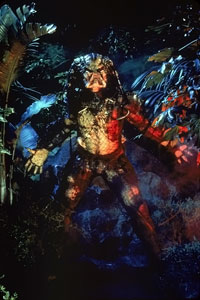
The creature found by the Challenger Expedition on the South American plateau.
The group of seven men are about to be set upon by a ruthless band of ne'er-do-wells in a seedy waterfront tavern when they are saved by a demure looking girl carrying an exotic repeating-fire rifle. It's none other than Jane Austen, Britain's greatest spy-assassin, covertly sent by the British government to assist the expedition. Challenger readily accepts her request to join the expedition and they set off into the interior the next day.

Andrew McGill, member of the 1870 Challenger Expedition and Governor of California, 1899-1903.

Henry Gage, member of the 1870 Challenger Expedition and Governor of Minnesota, 1887-1889.
Dinosaurs in South America? No. But there is something far more deadly lurking inland, something not from this world. Something that has come to hunt the most dangerous game.
Our intrepid band of adventurers barely escape with their lives after finally defeating a nearly invincible warrior from another world. The incredible power of his final act of self-destruction becomes known through vague rumors in the nearby French colony of Guiana, leading to its reference as a propulsion system in French author Jules Verne's "20,000 Leagues Beneath the Sea". Back home in Britain, the government later convinces H.G. Wells to write a novella about an invasion from Mars to distract the public about the continuing rumors of solitary hunters from a far more distant planet (much as the U.S. government later had to convince Wells' American cousin Orson Welles to distract the public from a similar case in Pennsylvania with a radio play about an alien landing in New Jersey followed by loud public claims that it was just a radio play).
Coincidentally, two of the members of the expedition are Andrew McGill and Henry Gage, who go on to serve as the Governors of California (1899-1903) and Minnesota (1887-1889), respectively.
Yes, when I pitched this in the spring of 2009 a "Pride and Predator" film was in production, as reported by "Variety". However, since the first four months of 2009 had already seen two Hollywood movies about mall cops, it seemed reasonable that not only could this title be successfully pitched, but it might open the floodgate for further Jane Austen action-adventure scripts.
SHERLOCK'S LADIES [weekly detective series]
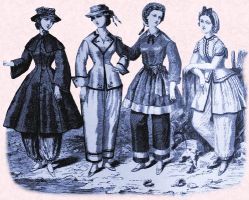
Jane and the three Brontë sisters in relatively skimpy Victorian era woolen bathing costumes.
It's the age of steam power and gas lamps, and crime is afoot in London.
Three beautiful and daring women — government spy/assassin Jane Austen, former constable Charlotte Brontë, and her sister Emily Brontë — undertake criminal investigations under the direction of the mysterious and entirely unseen Sherlock Holmes.
The girls meet with Holmes' representative Doctor Watson at 221 Baker Street. They never see their mysterious boss, who communicates with them exclusively via an acoustic speaking tube, apparently (although we're never quite certain) from his home upstairs at 221B Baker Street.
Holmes' detective operation is famously successful, but he and Watson take the credit while Austen and the Brontës take the risks. Meanwhile, the girls maintain elaborate cover identities as authors to more easily infiltrate upper-crust English society and catch their criminals.
For Sweeps Months specials pandering to ratings, the third Brontë sister Anne will appear as a Special Guest Star. Far less qualified, she is featured mainly to parade in a skimpy (for the era) 30-pound woolen bathing costume.
Pitched the week of Farrah Fawcett's death
JANE AUSTEN: THE BIOMECHANICAL WOMAN [action/adventure]
From the creators of JANE AUSTEN: TERMINATION WITH PRIDE AND EXTREME PREJUDICE comes another exciting chapter in the life of the 18th-19th century author/spy/assassin.
It's 1820 in Bath, in south-eastern England. Jane Austin, apparently a demure author but really one of the deadliest assassins in the service of the government of King George I, lies near death. Ironically, it isn't the work of an agent of a rival government, but she had too much mead in an ale-house and stepped out in front of an ox-cart.
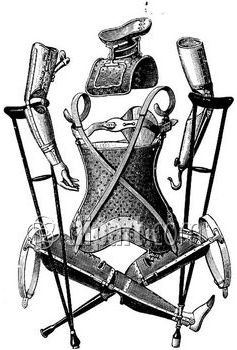
Some of the sophisticated hardware available to Doctor Rudolph Wells and his team
Stung by the loss of the American colonies a few years before, and the fact that England seems to have missed its chance at pounding France after their foolish and disastrous attempt to march on Moscow, George I is despondant. And the apparent loss of his most prized agent just makes things worse.
However, his Minister of Espionage, one Oscar Goldman, appears at court with surprising good news. Rudoph Wells, the Royal Physician, has announced that he can, with the aid of the empire's best barber-surgeons, repair her. As he puts it: "We have the needed early-19th-century technology." She can be, well, certainly not any better than she was before, and not even close to as good as she used to be, but with the addition of a glass eye, a wooden leg, and a hook for a hand, she can still take on any of His Majesty's assignments. As long as the assignment doesn't require too much agility, manual dexterity, or depth perception.
Using her cover as a seller of hay-filled sleeping mats, Jane is soon stealing the secrets of the Hapsburg Empire.
Of course, as with any such story about Georgian-era spy-assassins, the expected action and suspense is mixed with human drama. How will Jane Austin deal with her situation? Will she be somehow less of a woman for her loss? Or will her love affair with fellow Romantic-movement writer and covert agent Williams Wordsworth heal her spirit when he promises, in verse, to "make her a whole woman"?
JANE AUSTEN: EMMA ANIME [action / animation / fantasy]
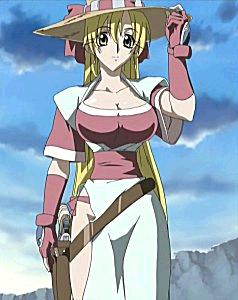
Jane Austen before her ox-cart accident in Bath.
1852: Britain's last acknowledged war with the United States has been over for forty years. (overlooking, as always, the covert Mexican Entente of 1830-1834 and the officially denied Albertan Incursion of 1842) Now the two great nations have entered into a lasting alliance.
Jane Austen used to be Britain's greatest secret agent. But her tragic ox-cart accident and subsequent reconstructive surgeries [detailed in JANE AUSTEN: THE BIOMECHANICAL WOMAN] have left her far less useful, what with the glass eye, the wooden leg, and the hook for a hand.
So, when the United States is assembling a diplomatic team for Matthew Perry's U.S. Navy expedition to forcibly open Japan to the west, the aging and now far less useful Jane Austen is attached to the team.
1853-1854: Perry's "Black Fleet" successfully opens the closed hermit kingdom of Japan to the outside world. And an English secret agent stays behind. To the Americans she was a stay-behind deep-cover agent. To the British this was a convenient way to get rid of a no longer useful agent.
Little did they know what would happen.
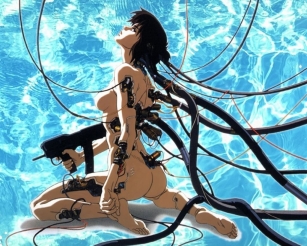
Jane Austen's mechageisha as it exists in 2029, known as Emma to the Osaka Cyberforce.
1856: The cunning Japanese scientists apply their newly developed techniques to convert Jane into what they call a mechageisha, a partially mechanical and entirely deadly woman.
1860-1865: The Centralized Information Agency established by President Lincoln [depicted in ONE SCORE AND FOUR] hears vague rumors of a Japanese super-agent. But the pressures of the pursuit of "Booth" and The Organization and the apparent assassination of Lincoln in April 1865 prevent investigation.
1904-1905: The Russo-Japanese War is fought in Southern Manchuria and at sea around the Korean peninsula. Rumors abound of a deadly female sniper on the Japanese side, but no specific details emerge from this war between two highly secretive governments.
2029: Many years have passed since the departure of Perry's naval fleet, roughly 1.75 centuries. Jane Austen, or her mechageisha, is still alive, or at least what passes for alive in what has been for over a century an entirely mechanical and frequently improved being containing the soul of Jane Austen. She is a secret policewoman with the Osaka Cyberforce using the cover name of Emma and fighting the criminal hacking societies largely controlling the economies of the Pacific Rim. At the same time she struggles to function according to the complex system of manners and standards of polite behavior found in Japan. Emma (or at least her mechageisha) is young, beautiful, smart, and witty, with a circle of friends for whom she attempts to function as a match-maker. She is also a dead shot with a highly modified .50 caliber Desert Eagle pistol. There are secret engagements, futuristic firefights, scoldings for thoughtless insults, superhuman feats, admissions of love, and postcyberpunk sprawl.
[As for the period 1934-1945 and the attempted establishment of the Greater East Asian Co-Prosperity Sphere, the brutal invasion and occupation of several Asian nations, and medical experimentation on civilians and prisoners of war, JANE AUSTEN: EMMA ANIME will follow the example of the Japanese government: ignore this period if possible, deny it if necessary.]
LA FEMME GEENITA [action/adventure]

Eerily paralleling the life of actress Geena Davis while erratically paralleling the plotline of "La Femme Nikita" and echoing the true-life adventures of author/assassin Jane Austen, this film follows the life of an actress who gives up the life of a thespian for that of an aspiring Olympic archer.
Leaving Hollywood for the archery range, our heroine dedicates herself to the zen of archery.
That is, until the day that a shadowy government agent appears and forces her into an offer she cannot refuse. Become a bow-wielding government assassin, or lose everything she cherishes.
How will Geenita deal with this wrenching change in her life?
This really happened, or at least the parts of it
that aren't "La Femme Nikita" did:
http://sportsillustrated.cnn.com/olympics/news/1999/08/05/davis_archery_ap/
"Thursday August 05, 1999 12:46 PM
LOS ANGELES (AP) -- Oscar-winning actress
Geena Davis, one of the nation's best with
a bow-and-arrow, is a women's Olympic archery
team finalist.
"Yes, Geena Davis is one of the top 32,"
National Archery Association spokeswoman
Kathleen Frazier confirmed Thursday.
Outside of the competitors, apparently no one
noticed the "Thelma & Louise" star was
advancing through the ranks of Olympic
hopefuls.
"She just wants to keep a low profile,"
Frazier said. [....]"
G.I. JANE EYRE [action/adventure]
The Victorian era was a long period of peace, prosperity, refined sensibilities, and national self-confidence for Britain, largely because of its powerful military and secret service. The Pax Britannica relied on agents like Jane Austen, a self-reliant proto-feminist of the era.
Jane is controversially allowed to train with a group of Royal Marines joining Her Majesty's Special Boat Service, shaving her head in one powerful scene so as to better fit in with them. Near the end of the training cycle, the Royal Navy learns that one of its lighted buoys powered by a mixture of caesium and white phosphorus has come loose from its mooring and drifted ashore on the Barbery Coast.
Fearing what the Ottoman Corsairs might do with the militarily useful material, the Royal Navy dispatches the as-yet incompletely trained SBS troopers to the Algerian coast. In the process of recovering the sensitive material (and rescuing a group of Polish missionaries kidnapped by the Barbary pirates, including a young girl named Marie Skłodowska who was so fascinated by the mysteriously glowing metal that she vowed on the spot to study chemistry when she grew older), Jane saved her entire platoon and their Command Master Chief leader.
On her return to Britain, she is quietly transferred out of the newly formed Her Majesty's Special Boat Service squadron six and given the cover name of Jane Eyre. In the guise of a London patrolwoman she seems to have accidentally killed a drunken man who was assaulting his pregnant wife. In reality he was an Austro-Hungarian secret agent.
Jane is incarcerated in prison in order to get close to a criminal mastermind thought to be operating his illicit network from behind bars. The grim setting causes her to have flashbacks to her childhood in Lowood Institution, a medium-security orphanarium notorious for its cold rooms, thin clothing, bad meals and typhus epidemics.
The group of prisoners is to be transferred from Wormwood Scrubs to Poultry Compter in an experimental dirigible, Dr William Bland's "Atmotic Airship". Once in flight, the criminal mastermind commandeers the airship. After a pitched battle aloft, Jane recovers control of the airship and safely lands it within the walls of Horsemonger Lane Gaol.
On brief leave before returning to her normal duties, she seduces a man named Edward Rochester. Rochester was married, and when his wife learns of his brief affair she sets fire to their country estate. Rochester loses an eye and a hand trying to fight the conflagration. While Jane has no lingering romantic interest in Rochester, the gentility of the period and her kindness (at least to those not her targets) leads her to introduce Rochester to the esteemed surgeon Doctor Rudolph Wells, who has recently pioneered some revolutionary surgical techniques. (Wells, of course, reappears in JANE AUSTEN: THE BIOMECHANICAL WOMAN.)
REALLY LITTLE WOMEN [science fiction]
Doctor Rudolph Wells (seen in G.I. JANE EYRE and JANE AUSTEN: THE BIOMECHANICAL WOMAN) has developed a Reduction Beam powered by the largest voltaic pile operated by Her Majesty's British Government.
Britain and Tsarist Russia are competing for the technology. The Tsarist scientist Jan Benes has slipped out of Russia, made his way across the continent by train and crossed the channel from Calais to Dover. He falls ill soon after his arrival in Britain due to his having subsisted on nothing but salted beef and unripened persimmons during his weeks of travel.
As Benes' condition progresses from constipation to impaction, Wells suggests that his Reduction Beam be applied in a daring procedure. A medical team of four specialists will be Reduced and sent in to fight the blockage! The four are sisters of the March family:
Margaret, known as "Meg" and considered The Beauty.
Josephine, known as "Jo" and considered The Tomboy.
Elizabeth, known as "Beth" and considered The Even-Tempered.
Amy, known as "Amy" and considered The Snow-Maiden.
The four women are Reduced by Doctor Wells' Reducing Beam, to the incredibly small size of just one centimeter in height! They and a tiny rowboat are then introduced into Benes' body by the (for that period) advanced technique of a high colonic. They must make their way through Benes' lower digestive tract and soften the impaction with the light from a shuttered lantern, and then make their way back out before the effects of the Reducing Beam wear off and their return to their normal size, killing Benes in the process.
The tension is heightened when Meg realizes that Beth is not just the Even-Tempered, but she is also a Tsarist spy sent on the mission to kill Benes and deny his knowledge to the British. The Tsarist plot was so complex and long-term that it involved infiltrating Beth into the March family and having her raised as a sister to the three true March girls. This was made easier by the dimwittedness of the March parents, much like the victims of the cuckoo and other brood parasite bird species.
Beth's sabotage to the shuttered lantern is quickly repaired (a metal lantern is not a terribly delicate instrument, after all), the impaction is softened, and the girls prepare to make their way back out of Benes' body. In a final desparate struggle, Beth is killed. Her body is quickly stuffed into a diospyrobezoar, an indigestible mass of plant material formed from all the unripened persimmons Jan Benes had consumed during his journey. The other girls make it out just in time, returning to their normal size within seconds of escaping from Benes.
For those expecting Beth's body to have been thrown into a phagocytic white blood cell, she was still 1 cm tall. A white blood cell is only 1-2% that large. Besides, phagocytosis was only discovered by Russian zoologist Ilya Mechnikov in 1882. If this film is to be acclaimed for its scientific accuracy, technical details like this need careful attention.
However, a post-credits scene shows Meg meeting with a Tsarist agent in a foggy Berlin, where in return for keeping Benes in Britain, she suggests that the Russians have their top zoologists look into cells specialized for defense against microbial infections.
RLW2: EVEN LITTLER [science fiction]
A sequel to REALLY LITTLE WOMEN.
While the bezoar has, so far, prevented Beth's body from returning to its normal size while still inside Jan Benes, the three girls have to go back in and retrieve the bezoar before it weakens and leads to Benes' immediate death.
Categories and Titles
Back to The Nonsense Page
Back to Bob's home page